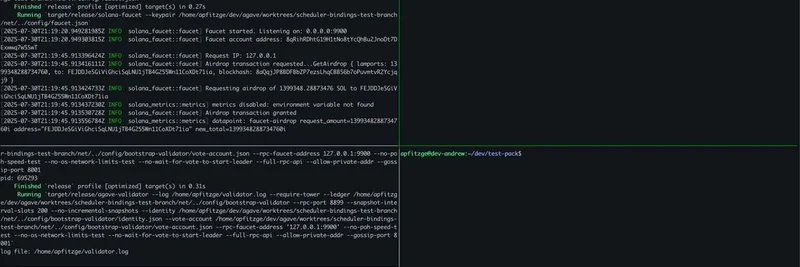Hey there, fellow tech enthusiasts! Today, we're diving into an exciting update from Andrew Fitzgerald, a prominent figure in the blockchain space. Andrew recently shared a significant milestone in his work on an internal scheduler branch, and we're here to break it down for you. Let's get started!
The Journey of Optimization
Andrew's tweet here highlights a remarkable achievement: starting with an external pack that had performance issues, switching to an internal scheduler, fixing a bug, and restarting the external pack—all within just 1 minute and 6 seconds. This progress is a testament to the relentless pursuit of efficiency in blockchain technology.
The image above captures the essence of this journey. It shows multiple terminal windows, each displaying different aspects of the development process. From the initial setup to the final optimization, every step is meticulously documented. This visual representation not only showcases the complexity of the task but also the methodical approach Andrew took to achieve his goal.
Understanding the Internal Scheduler
For those of us who might not be deeply entrenched in the world of coding, let's break down what an internal scheduler is. In simple terms, a scheduler is a component of an operating system that decides which processes should run and for how long. An internal scheduler, as opposed to an external one, is integrated directly into the system, allowing for more seamless and efficient management of tasks.
Andrew's switch to an internal scheduler was driven by the need to improve performance. External schedulers, while useful, can sometimes introduce latency and overhead. By moving to an internal solution, Andrew was able to reduce these inefficiencies, leading to a more responsive and reliable system.
The Bug Fix and Restart
One of the critical moments in this process was fixing a bug. Bugs are inevitable in software development, but the speed and effectiveness with which they are addressed can make all the difference. Andrew's ability to identify and resolve the issue quickly is a skill that many developers aspire to. This fix was crucial because it ensured that the internal scheduler could operate without interruptions, further enhancing its performance.
After the bug was fixed, the external pack was restarted. This step was necessary to integrate the changes and ensure that the entire system was functioning harmoniously. The restart, combined with the internal scheduler, resulted in a significant performance boost, as evidenced by the timeline Andrew shared.
Progress Over the Past Two Weeks
Andrew's tweet also mentions the great progress made over the past two weeks. This period of intensive work has been focused on polishing the internal branch and starting to split PRs (pull requests). For those unfamiliar, pull requests are a way for developers to propose changes to a codebase. Splitting them allows for more manageable and reviewable chunks of code, facilitating collaboration and ensuring quality.
This approach is particularly important in open-source projects, where multiple contributors are involved. By breaking down the work into smaller, more digestible pieces, Andrew is making it easier for others to contribute and for the project to evolve. It's a strategy that not only accelerates development but also fosters a sense of community and shared ownership.
Implications for Blockchain Practitioners
So, what does all this mean for blockchain practitioners? Firstly, it underscores the importance of continuous improvement and innovation. The blockchain space is rapidly evolving, and staying ahead requires a commitment to optimizing every aspect of the technology. Andrew's work on the internal scheduler is a prime example of how small changes can lead to significant improvements.
Secondly, it highlights the value of transparency and documentation. By sharing his progress and the steps he took, Andrew is contributing to the collective knowledge base of the community. This openness is crucial for fostering learning and collaboration, which are key to advancing the field.
Finally, it serves as a reminder of the challenges and rewards of software development. The journey from identifying a problem to implementing a solution is often fraught with obstacles, but the satisfaction of overcoming them and seeing tangible results is unparalleled. Andrew's experience is a motivational story for anyone working in tech.
Conclusion
Andrew Fitzgerald's recent progress on the internal scheduler branch is a compelling narrative of innovation and perseverance. From tackling performance issues to fixing bugs and restarting the external pack, every step has been a move towards greater efficiency and reliability. As blockchain practitioners, we can learn a lot from his approach—embracing change, valuing collaboration, and never settling for less than the best.
Stay tuned for more updates, and keep pushing the boundaries of what's possible in the world of technology!


